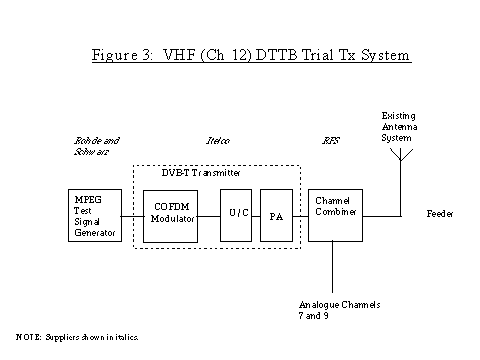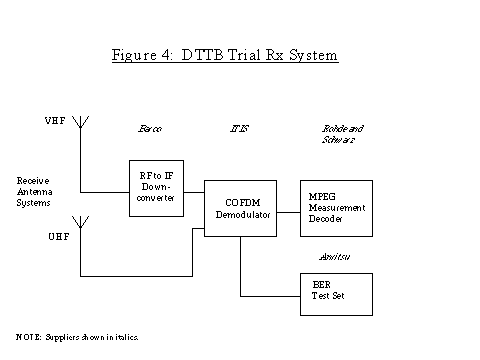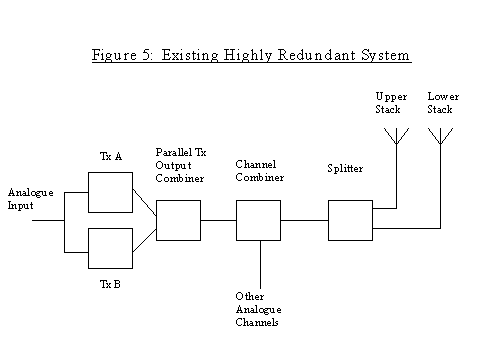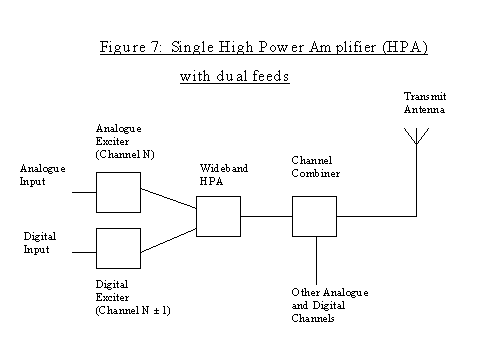
Digital Terrestrial Television Broadcasting:
An Overview of the NTA Trials and
Some Implementation Issues

Stephen Farrugia
Senior Engineer
Technical Strategic Planning
National Transmission Agency
ABA Planning Conference
February 1998
Note – Some of the dates and timings mentioned in this paper have changed.
Introduction
This paper will outline the equipment purchased for the NTA trials and the objectives of the trials. DTTB implementation issues such as adjacent channel combining, splitting transmit antennas and the use of Single Frequency Networks for television, will also be discussed.
NTA DTTB Trials
By way of introduction to the building blocks for Digital Terrestrial Television, the following diagram, Figure 1, is provided to show the equipment in a generic DTTB transmission chain.

The NTA has chosen the DVB-T system for the trials as equipment is readily available for purchase. (Equipment for the ATSC system was not readily available for purchase at the time NTA was placing orders.) This equipment will allow realistic investigations into the implementation issues regarding the introduction of digital television into the national transmission network. The trials will be conducted in Canberra with the transmission equipment to be installed at Telstra Tower. Telstra Media and Broadcasting staff will be assisting the NTA with the trials.
Figure 2 shows the proposed UHF trial transmission arrangement. An MPEG-2 test signal generator is used to generate the MPEG-2 transport stream (TS) in lieu of the video and audio encoders and multiplexer. This option provides all the functionality that the NTA requires for its trials. It is expected that the broadcasters may well provide a suitable MPEG-2 TS to the transmission site as part of a transmission agreement. A converted NEC 5kW PAL transmitter is to be used in the UHF trial which will be fed by an ITIS COFDM modulator. RFS are supplying the UHF adjacent channel combiner to allow the transmissions to be broadcast from the existing antenna simultaneously with the existing PAL transmissions.

Figure 3 shows the proposed VHF trial system. In this case, a purpose built DVB-T transmitter from Itelco is to be used. Itelco have kindly allowed the NTA to borrow this transmitter until the end of June 1998.

Figure 4 shows the proposed receive system for the DTTB trials. This system will allow both VHF and UHF field measurements of both MPEG errors and BER. Field strength and picture quality of both the analogue and digital services will also be recorded for comparison purposes.

These digital television trials will provide valuable information about the potential impact of digital television on the national transmission network. The experience gained through this project will also assist the NTA in development of technical specifications for future digital television equipment.
Implementation Issues
Infrastructure Background
Most of the main regional broadcasting towers in Australia were initially designed for one or two VHF television services. Some FM capacity was made available during the 70s and 80s. During the Equalisation program (late 80s early 90s) most of the support structures in eastern Australia were rebuilt, strengthened or replaced, to accommodate UHF television antenna systems and upgraded VHF-FM antenna systems. Increasing numbers of radiocommunications and telecommunications sharees, as well as the presence of Pay TV MDS operators, now mean that most antenna support structures are nearing their full capacity in terms of aperture (tower space) availability and/or wind loading capacity. What is more, environmental considerations/restrictions would make replacement of most antenna support structures very difficult, if not impossible.
On the ground, similar arguments apply. The buildings were generally designed for two VHF television transmitters and although transmitter sizes have reduced with time, the addition of two or three UHF transmitters and a similar number of FM transmitters has meant that there is little capacity in existing buildings for additional transmitters. But the addition of a new building or extension to the existing building will generally be feasible, because impact on the environment will probably be minimal.
Receive System Issues
Outdoor receive antennas are in widespread use around Australia, particularly in regional areas. Co-siting DTTB transmissions with existing analogue television transmissions in the same band, with the same polarisation, will allow the general public to access the digital signals with a minimum of equipment changes.
It is with this background that we approach the implementation issues surrounding DTTB. Therefore, if we assume that the existing transmit arrays must be used, we can look at how that can be achieved.
Transmit Antenna System Limitations
Most high-powered UHF main sites transmit horizontally-polarised signals, generally using panel antenna arrays. Whilst individual horizontally-polarised panel antennas are specified to cover all of Bands IV and V, the antenna arrays are optimised for performance on the currently operating (analogue) channels. Performance of these panel arrays at significantly different frequencies would need to be assessed on a case-by-case basis. Similarly the power handling capabilities of the antenna system and return loss of the system on the proposed digital channels would need to be considered on a case-by-case basis.
Three Solutions to Adjacent Channel, Same-Site Operation
Following on from the transmit antenna system limitations, most of the DTTB services may use the same polarisation as existing analogue channels from a main site and occupy the channel adjacent (upper or lower) to its analogue channel. To achieve this adjacent channel operation, a number of solutions have been suggested:



Even though there are a number of implementation issues which tend to favour the use of adjacent channels for DTTB services, it is unlikely that the frequency assignment problem will be so easily resolved in practice. This is primarily due to the operation of adjacent (analogue) channels in adjacent areas. Mr Peter Gough will elaborate on this point in his paper.
Single Frequency Networks (SFNs)
The discussion thus far has focussed upon the main sites. The issues surrounding translator sites are similar, but with a twist. Some of the frequency planning work for DTTB in Australia has assumed that the use of Single Frequency Networks within a (pre-Equalisation) commercial television licence area was possible. The DVB-T system does allow this option. Whilst there have been some claims about the usefulness of the ATSC system for SFN operation, I am not aware of any field trials which have shown this functionality. As SFN operation is an issue, here are some points for consideration.
Program distribution to each of the sites in SFN will need to be addressed. The signal could be distributed to the transmission sites within an area by off-air reception from the main site, dedicated digital link or satellite. In the off-air case, sufficient isolation will be required between the input and output signals to avoid feedback into the amplifier system. Dedicated digital links will be expensive when the payload is around 20Mbps. Whilst satellite delivery may be an option for the national broadcasters, the requirement for regional content on the commercial networks may preclude this delivery solution.
Also, to ensure correct operation of an SFN, timing of transmission of the signals from each transmission site is important, as is frequency locking. Distances between transmitter sites must be taken into account when considering whether to use an SFN and if so, which transmission parameters best suit the network topology.
The introduction of an SFN approach, using digital transmissions on adjacent channels to the analogue transmissions, may cause adjacent channel interference. There should not be any adjacent channel interference generated from the main site if the transmission systems are well designed. However, adjacent channel interference may occur when residents within a translator’s designed coverage area choose to use the main site’s transmissions. In this case, it is likely that the analogue reception from the main site will be interfered with by the local digital transmissions. Generally, this could be resolved by the resident viewing all transmissions from the local translator site.
An alternative to the use of SFNs is to use adjacent channels to those currently in use at the translator sites (similar to the main site scenario). This alternative is unlikely to be viable due to the large number of frequencies required and the scarcity of broadcasting spectrum.
Conclusion
This paper has provided a brief overview of the upcoming NTA DTTB trials and discussed some of the key implementation issues. The existing infrastructure and its impact on the introduction of DTTB were discussed as were some of the reasons for using adjacent channels for DTTB services at main sites. Three possible solutions to the implementation problems of providing adjacent channels for a site were provided with their pros and cons. The use of Single Frequency Networks in medium sized areas, as has been assumed in some planning work, was also briefly analysed.
Acknowledgments
The author would like to thank the management of the NTA for their continued support and other DTTB "Technical Experts", particularly Mr Peter Gough, within the industry for the many constructive discussions.
References